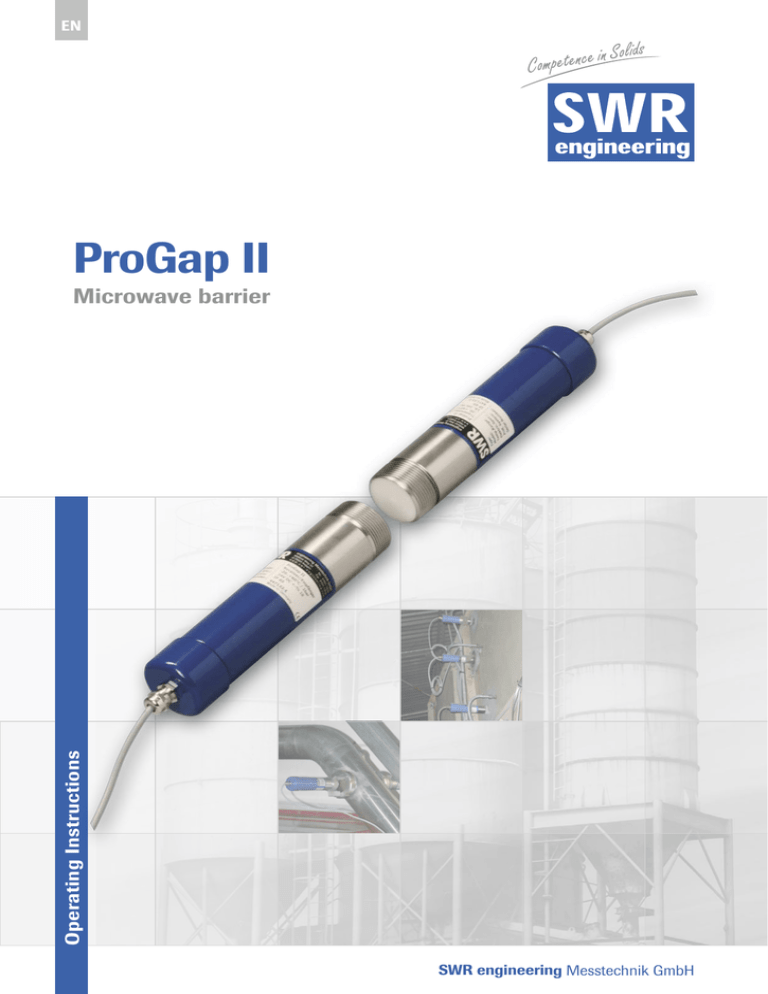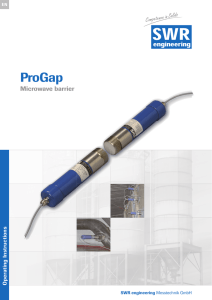BA_ProGap-II_EN 070426b.ind
advertisement

EN ProGap II Operating Instructions Microwave barrier SWR engineering Messtechnik GmbH Operating Instructions Contents 1. General Comment .................................................................................................. 3 2. Technical Data ........................................................................................................ 3 3. Installation ................................................................................................................ 4 4. Connection ............................................................................................................... 4 5. Commissioning ....................................................................................................... 5 6. Trouble shooting ..................................................................................................... 6 7. Notice ........................................................................................................................ 6 8. Declaration of conformity ..................................................................................... 6 2 Operating Instructions 1. General Comment The radar barrier is a contactless measuring method and can be used for metallic as well as non-metallic ducts, bunkers, shafts, free-falling stretches, expansion bellows etc. Since it can penetrate non-conductive material, e.g. such as plastics, it is possible to detect from the outside or through a window. The metering thus can be completely decoupled from the process, e.g. for measuring aggressive, abrasive or bulky material. Even at difficult conditions – like temperatures of up to 200 °C, pressure of up to 20 bar or all dust Ex-zones – the ProGap II can be used by means of a process adapter. 2. Technical Data 3 Housing material Stainless steel 1.4541 Protective system IP 65; DustEX (optional) Ambient temperature -20…+60 °C Working pressure (max.) 1 bar (as standard version) Detection range 0…4 m 0…18 m > 18 m on demand Power supply 24 VDC (- 0 / +15 %) 24 VAC (- 0 / +15 %) Power consumption Approx.. 1,8 VA Current consumption Max. 100 mA Relay output (max.) • voltage • current • capacity 250 VAC 1A AC/DC 60 VA, 50 W Response time 0,25 s…5 s (continuously adjustable) Measuring frequency K-Band 24.125 GHz ± 100 MHz Transmitting power Max. 5 mW Weight Transmitter 1.1 kg Receiver 1.1 kg Operating Instructions 3. Installation 3.1 Basic remarks The fitting position of the devices is arbitrary, however, absolute attention must be paid to the same fitting position of transmitter and receiver (marking of each device at the top) and to the very exact justification to each other (see below fig.). Transmitter Receiver Fig 1: Installation Transmitter and receiver must face each other with their front side on the same level. 4. Connection The connection of the sensor has to be carried out according to below figures. white brown 1 2 supply voltage 24 V white brown green yellow grey Fig 2: Transmitter 1 2 3 4 5 Fig 3: Receiver For the 2-wired connection to the transmitter a current installation cable can be used. 4 supply voltage 24 V 120 V 0,5 A 24 W 60 VA Operating Instructions 5. Commissioning All necessary control elements for the alignment are in the receiver. P1: P1 Sensitivity fine Adjustment of the sensitivity LED P2 Response time P2: Adjustment of the time delay of the signal. S1: Halving or doubling of the sensitivity LED red Field intensity red LED : The flashing shows the signal intensity; Fast flashing = high signal. LED out = no signal received. LED green Switching status plug S1 1 2 1 2 3 4 5 S1 Sensitivity rough P1 P2 Fig 4: Receiver green LED: Indicates the switching status of the relay. LED on = relay closed. Adjustment of the sensitivity Potentiometer P1 With the potentiometer P1 and the switch S1 the sensitivity can be adjusted. The microwave barrier is adjusted in such a way that clear distinctions between interrupted or damped resp. not-interrupted microwave beam are made. Proceeding: With not-interrupted beam and flashing red LED turn P1 anticlockwise until the green LED lights. Now interrupt the beam path (put the material to be detected between the transmitter and the receiver) and turn P1 only so far clockwise until the green LED goes out. Repeat this procedure. If the green LED still lights, even with a complete left turn of P1, and furthermore the material has a low dielectric constant and weak damping (e.g. paper, plastics, foams, etc.), please contact SWR engineering GmbH. If the red LED should not light, put the switch S1 to position 2. If this LED does not light even in the most sensitive position, then the receiver does not get any signal from the transmitter. In this case examine the microwave barrier for faultless function by clarifying the following possibilities: • • • • wrong adjustment of the barrier to each other the distance between transmitter and receiver is too large too much damping material in the beam path damping built-up at the sensors. Adjusting of the switch response time Potentiometer P2 Finally adjust the switch response time with the potentiometer P2 according to your requirements between the range of 0.25 and 5 seconds. By turning P2 anticlockwise, the delay increases. Thereby a fluttering of the relay can be stopped, which have been produced by critical adjustment of the sensitivity. 5 Operating Instructions 6. Trouble Shooting If the green LED should not light even in the most sensitive setting (potentiometer P1 turned completely to the right and switch S1 on the position 2), when there is material between the transmitter and the receiver, it could be possible that the maximal detecting range is limited due to the following: • the position of the installation places to each other • the position of transmitter to receiver • the distance between transmitter and receiver is too large. 7. Notice • Avoid reflections on metallic parts • Adjust the amplification at the potentiometer P1 only as high as necessary 8. Declaration of conformity Conforms to the following Product Specifications: Ref. No.: EN 55011 EN 60555-2 EN 50081-1 EN 50082-1 pr EN 50082-1 pr EN 50082-2 Date: Edition 90 1987 1992 1992 1994 1994 Ref. No.: ENV 50140 EN 50141 ENV 50142 SWR engineering Messtechnik GmbH Gutedelstraße 31 · 79418 Schliengen (Germany) Fon +49 7635 82 72 48-0 · Fax +49 7635 82 72 48-48 · www.swr-engineering.com 6 EN 070426 (All rights reserved.) The product herewith complies with requirements of the EMC Directive 89/336/EEC.



